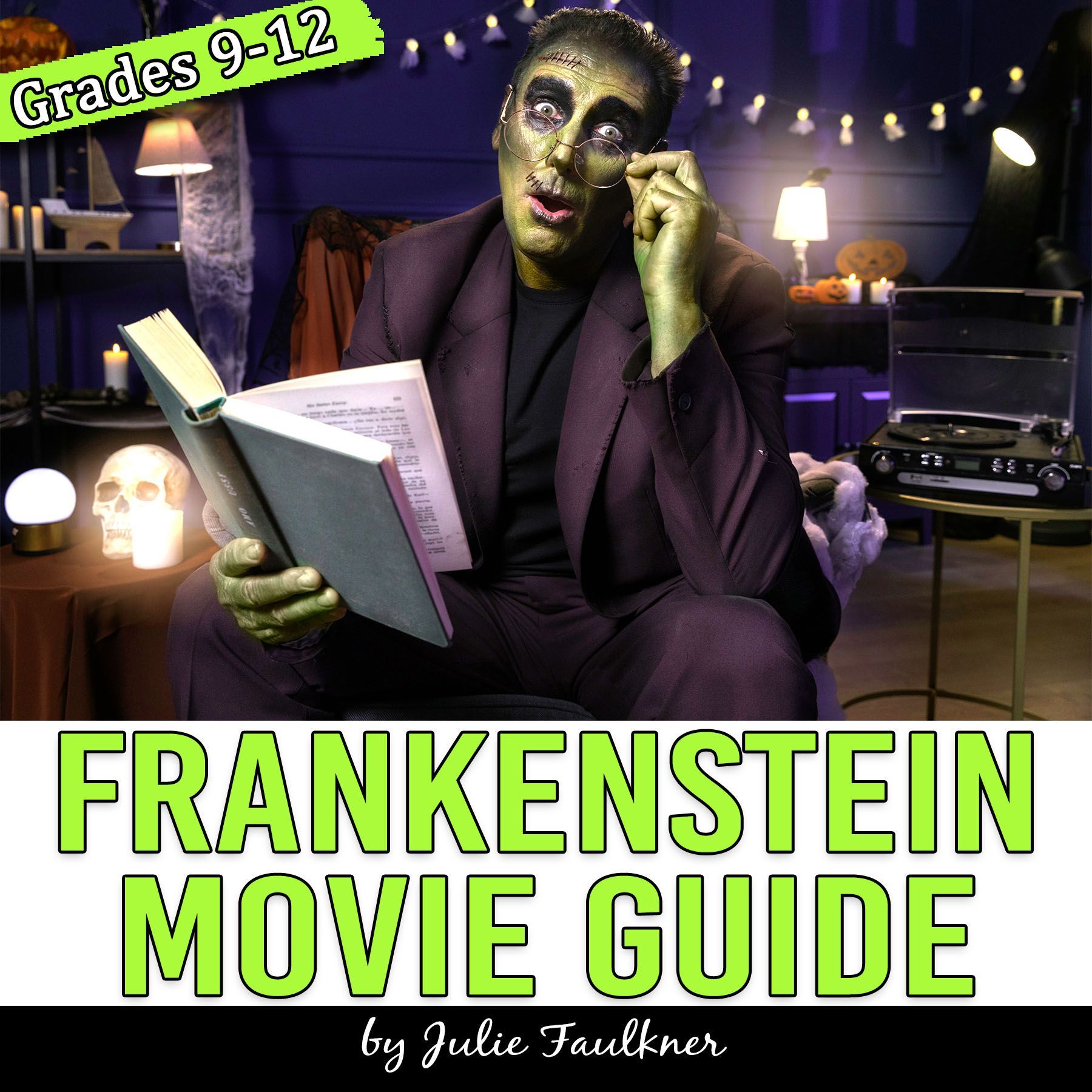Fun Halloween Activities for
Middle or High School Students
If bringing a little Halloween spirit into your middle or high school lesson plans is on your to-do list, then you’ve come to the right place! Halloween is one of my favorite times of year – probably because it’s my birthday – but I do just love it! Doesn’t that give me some pretty solid expertise for Halloween?!? 🙂 I’ve gotten together with some of my fellow teacher-authors (from all subjects) to bring you a carefully curated list of creepy creations for Halloween. Check out the ideas below to see some “spooktacular” Halloween lessons for middle or high school students that they are sure to love!
1. SPOOKY STORIES
What’s better than a spine-chilling, spooky story on Halloween?!?! Stories are an English teacher’s playground, and I love using stories and poems this time of year. One of my absolute favorite stories is the “Cemetery Path.” This short story is just the right amount of mystery to keep kids engaged while covering some key skills. Below is a student sample of a poetry-writing exercise to transform the short story into a poem that we did following an analysis of the short story. Talk about higher-order thinking skills! This NO PREP lesson is available in a bundle here.
If poetry is more your speed, check out “The Listeners.” I was first introduced to this poem in college. My methods teacher had a knack for finding the most interesting poetry to share with us. I’ve used it every year that I’ve had my own classroom, and kids are always intrigued and willing to create answers for all the unanswered questions the poem poses. After we read the poem, we do a creative, text-based, real-life, real estate project. Do you have the guts to sell a haunted house? This NO PREP lesson is available in a bundle here.
Those who teach Arthur Miller’s magnum opus or who have time for a full “Halloween-themed” unit could teach The Crucible. While there are no “real witches” in The Crucible, I always try and start this unit around October in the fall semester with my juniors. I’m always pleasantly surprised at how much my students enjoy this text and the modern, real-life connections I bring in as we work through the unit. My full literature guide is available here. Plus, it’s newly updated for digital use.
If poetry is more your speed, check out “The Listeners.” I was first introduced to this poem in college. My methods teacher had a knack for finding the most interesting poetry to share with us. I’ve used it every year that I’ve had my own classroom, and kids are always intrigued and willing to create answers for all the unanswered questions the poem poses. After we read the poem, we do a creative, text-based, real-life, real estate project. Do you have the guts to sell a haunted house? This NO PREP lesson is available in a bundle here. And, it’s updated for digital use, as well.
2. ESCAPE ROOMS
This time of year, going to a haunted house is on the top of everyone’s to-do list. What if you could bring that excitement in your classroom? You can– with educational escape rooms! So many now are ready-to-go for any subject. In fact, they are one of my favorite resources to create, and my students LOVE them. I’ve never seen them work so hard — while having so much fun — with a class assignment. I’m seeing them pop up for all subjects, and I think that is awesome: more classrooms joining in the on the fun. This escape game for Spanish class by Manzana para la maestra is so creative. Students read a one-page passage about Day of the Dead and complete five related puzzles.
One of my best-selling Halloween resources is my “The Legend of Sleepy Hollow” escape game. In this escape game with a flexible three-ways-to-play format, students must work to solve the clues in order to save Sleepy Hollow before the Headless Horseman strikes again! Students will review plot, irony, symbolism, read a paired info text, and figurative language.
Lately, I’ve created mini escape games for classrooms new to escape games or those with shorter class periods or just for teachers who want something shorter! They are quick 3-clue games that last about 30 minutes. For all of my fellow yearbook advisers out there, my newest mini escape game is a team-building exercise for yearbook staffs called The Mystery of the Abandoned House. Staffs are tested on their knowledge of photography, headline writing, and editing, all while solving the mystery of the abandoned house. How much fun is that!?!
All of my escape games are thematic, where all the clues link together for a dramatic ending, and they require students to demonstrate their knowledge of the skill in order to solve the clues. Check them all out here.
3. GETTING MESSY/HANDS ON/CRAFTS/GAMES
Goo, slime, smoke, steam, marshmallows, pumpkin guts, and more are all kinds of wonderful and lovely for Halloween lessons for middle or high school students, so why not use all that jazz to make learning fun on a day when traditional instruction is going to be a struggle?!?
I am honestly fascinated with STEM projects right now. It’s probably because I don’t teach a subject that really lends itself to experiments. Maybe in another life, I’ll be a science teacher. I think for now, I’ll just stick to science experiment object lessons with the kids at church, and just ooh and aah over the ones for classrooms from a safe distance — like this Halloween STEM Challenge from Kerry Tracy. Kerry even includes ideas for differentiation. Erin Hanson has also created a spooky science STEM activity where students actively engage in phenomena-based inquiry, observation, model creation, and analysis of phase changes and sublimation. Bone bridges? Ghosts in the graveyard? Dry ice? Count me in!
Another way to get hands-on at Halloween is with pumpkin carving, and maybe that’s not a super safe choice for your classroom, but this two-step equations build a jack-o-lantern for Algebra from 4 the Love of Math seems like an adorable alternative for math classes!
If you are a crafty friend, pull out the colored pencils and glue for these activities: -In this Day of the Dead Halloween activity students make their own papel picado with a stencil. -Who know Newton’s Law could be so much fun for Halloween? But it sure looks like it would be in this set of coloring pages where students create a Halloween inspired image using the thirty-four questions provided while reviewing force, motion, inertia, gravity, friction, mass, acceleration, velocity, action, reaction, and Newton’s first, second and third laws of motion. -Math students can also join in the coloring fun with Math by the Mountain’s Literal Equations Pumpkin Carving Coloring Activity. -My high school English students always love when we take a few minutes to color by parts of speech or figurative language… and I secretly love it, too.
So, since we know I’m not going to be doing any dry ice experiments for Halloween, one activity I love do – with any holiday, really – is my Real-World Grammar Fails task cards. I put JPEG images (they come in the pack ready to go) into Kahoot to turn it into a game. My kids (juniors and seniors) are crazy for Kahoot, and we always get so tickled by all the mistakes.
4. Listen and Watch
Halloween is most definitely a holiday that appeals to all the senses, and that makes it the perfect time to practice some listening and viewing skills. Podcasts are super popular right now, and one of my favorites for this time of year is Lore. Pick your favorite episode and pair it with one of my Podcasts Worksheets for any podcast for the perfect no-prep lesson. I also like this quick lesson from Reading and Writing Haven; it’s a chilling lesson plan specifically for a podcast about body farms! She recommends it for high school students. I also have the perfect podcast pages to pair with any Halloween podcast. They are FREE! Plus, get my full list of suggestions here.
Most of the time it’s easy for English or literature teachers to bring in a movie for students to watch based on a certain theme, text, or topic, but it seems other subjects – math especially – have to work a little harder. That’s why I was so excited to see this movie viewing guide for math from Hayley Cain at Activity After Math. This is a 20-question movie guide to accompany the movie Monsters, Inc. and the questions actually follow the movie and use scenes to build the word problems for students to answer. Skills-based: Check. Cool: Check.
Can we get through a Halloween post without mentioning Frankenstein? I mean, before zombies were cool, there was Frankenstein. It’s a classic for senior English and/or students in a British Lit class. The 2004 Lions Gate version with Don Sutherland is the best screen adaptation I’ve seen. It makes an excellent supplement or substitute for novel reading. My NO PREP Movie Viewing Pack is available here.
5. Frightful Facts
As an English teacher, I love exploring back stories, and it’s my experience that students actually enjoy reading nonfiction, too. I love what Solutions for Math did for this Algebra activity. On Halloween, with this calculator exercise, your high school math students will be engaged in solving problems while learning fun facts about the holiday. It’s kinda like a math mystery!
My Halloween-themed grammar worksheets are similar to this in that students will be reading facts about Halloween while practicing certain grammar skills. They are perfect for literacy centers, substitutes, or bell ringers. Plus, as an added bonus, they have cute age-appropriate clip art that students can color when they are finished.
In Conclusion
Perhaps one – or more – of these “daring” Halloween lessons for middle or high school students will be just the trick to get your students engaged in a positive and purposeful way this Halloween. I’m excited, as always, to be a small part of your classroom success story!
Love this content?
Sign up for my email newsletter with more tips, ideas, success stories, and freebies!





































